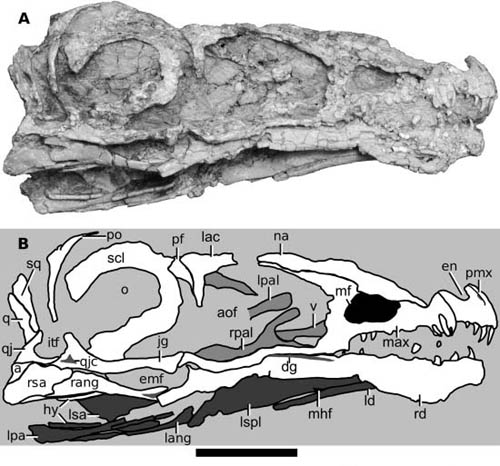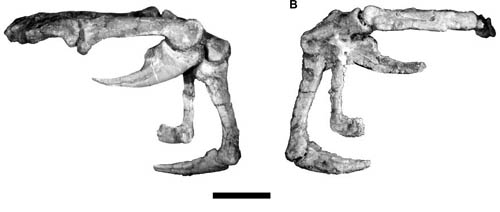Sino-American Expedition Produced a New Juvenile Coelurosaurian Theropod in Xinjiang, China
The Sino-American field expedition in the Shishugou Formation at the Wucaiwan locality in the Junggar Basin north of the Tian Shan in the Xinjiang Autonomous Region, co-led by Dr. XU Xing, Institute of Vertebrate Paleontology and Paleoanthropology (IVPP), Chinese Academy of Sciences, and Dr. James Clark of George Washington University, have produced a number of dinosaur fossils, including several species of small- to medium-bodied theropod. The team reported a new juvenile coelurosaurian theropod, Aorun zhaoi gen. et sp. nov., from the upper part of the Middle to Upper Jurassic Shishugou Formation online May 3 in the Journal of Systematic Palaeontology. Aorun is the seventh theropod taxon, and temporally oldest coelurosaur, known from the Shishugou Formation, providing new information on the morphology of basal coelurosaurs from the Middle–Late Jurassic.
The new specimen, IVPP V15709, was discovered during the field expedition in 2006. It consists of a skull, the lower jaws, a neck vertebra, a dorsal vertebra, three tail vertebrae, the left ulna and hand, the lower ends of both pubes and both lower legs.
The generic name is derived from Mandarin Chinese and is actually a shortened masculine name of Ao Run, who is the Mandarin mythical deity, the Dragon King of the West Sea in the epic Journey to the West. The specific name honours late Professor Zhao Xijin of the IVPP.
Histological analysis of the holotype and only known specimen shows that the new species is represented by the skeleton of a juvenile individual aged no more than one year. The new theropod was estimated 1 meter or just over 3 feet long, and probably weighed about 3 pounds.
Aorun is one of the oldest known coelurosaurian dinosaurs and is estimated to have lived about 161.5 million years ago during the Late Jurassic Period. It is different from other theropods discovered from the same region, such as Guanlong, Haplocheirus, Limusaurus, Monolophosaurus, Sinraptor and Zuolong. Researchers placed Aorun in a basal position in the Coelurosauria, but is in any case more derived than the Tyrannosauroidea. Possibly it is a member of a Coeluridae that is the basalmost clade of the Maniraptora.
“Aorun lived more than 161 million years ago, in the earliest part of the Late Jurassic Period. Its small, numerous teeth suggest that it would have eaten prey like lizards and small relatives of today’s mammals and crocodilians”, said first author Dr. Choiniere, now a senior researcher at the Evolutionary Studies Institute at the University of the Witwatersrand in Johannesburg, South Africa.
This research was funded by the Chinese National Natural Science Foundation and the US National Science Foundation.

Fig.1 Skull and mandible of Aorun zhaoi (IVPP V15709). A, right lateral view; B, line drawing of right lateral view. Scale bar equals 1 cm. (Image by IVPP)

Fig.2 Left manus of Aorun zhaoi (IVPP V15709). A, medial view; B, lateral view.Scale bar equals 1 cm. (Image By IVPP)
Download attachments: